Physical Address
304 North Cardinal St.
Dorchester Center, MA 02124
Cystic lesions of bone represent a heterogeneous group of entities in which the common feature is de novo formation of unilocular or multilocular cavities filled with blood, serous fluid, mucinous content, or keratin debris. Secondary cystic changes in preexisting conditions, such as in chondroblastoma, fibrous dysplasia, and giant-cell tumor, are discussed in conjunction with those underlying conditions. The development of secondary aneurysmal bone cyst engrafted on other lesions is also discussed in this chapter.
The term aneurysmal bone cyst was introduced by Jaffe and Lichtenstein. In their words “the term aneurysmal relates to a sort of blowout distention of the contour of the affected bone and the term bone cyst relates to the fact that it represents mainly a blood-filled cavity.” They defined this process in bone as a distinct lesion separate from giant-cell tumor and other entities containing giant cells.
Aneurysmal bone cyst is a multiloculated cystic lesion that almost always arises in bone and is also, although rarely, observed as a secondary phenomenon in certain soft tissue lesions. Most likely, it is initiated by an “injury” to the rich capillary network of the precursor lesion, culminating in an expansile destructive process caused by capillary pressure of the extravasated blood. Measurements of blood pressure in the cysts, the absence of clotting in the venules, and venographic studies indicate that the cysts are actively connected with the host capillary network. It has been postulated that intraosseous hemorrhage can provoke either a solid reactive lesion in the form of a giant-cell reparative granuloma or an aneurysmal bone cyst. Hence, some have proposed the term solid aneurysmal bone cyst for lesions that have large areas of solid tissue with features of giant-cell reparative granuloma and occur in sites typical for aneurysmal bone cyst. Lesions that do not develop a blowout component may represent an early stage of the process (i.e., are aneurysmal bone cysts in statu nascendi). Both benign and malignant bone lesions are prone to develop aneurysmal bone cysts as secondary phenomena superimposed on preexisting conditions. These lesions are referred to as secondary aneurysmal bone cysts.
Cytogenetic studies demonstrating clonal rearrangements of chromosomal bands 16q22 and 17p13 in at least some aneurysmal bone cysts have raised doubts about the reactive nature of these lesions. In fact, recent molecular studies have shown that t(16;17) (q22;p13) creates a chimeric gene in which a promoter region of the osteoblast cadherin ( CDH11 ) gene mapping to 16q22 is juxtaposed to the ubiquitin-specific protease ( USP6 ) gene mapping to 17p13 ( Fig. 15-1 ). Several variants of CDH11-USP6 fusion transcripts as well as alternative rearrangements of these genes were identified in a subset of primary aneurysmal bone cysts but not in secondary aneurysmal bone cysts. The chimeric CDH11-USP6 gene consists of the noncoding exon 1 and 2 of CDH11 fused to the entire USP6 coding sequence. The fusion breakpoints in various splicing variants are after the transcription initiation site of the CDH11 gene. The breakpoint of the second fusion partner is before the USP6 ATG transcription initiation signal, which results in up-regulation of USP6 ubiquitin-specific protease. USP6 has a high degree of homology to TBCID3 and USP32 genes, from which it evolved. It has also been documented that the presence of TBC1D3 and TBC domains is critical for the transforming activity of the USP6 protein. Several additional rearrangements of the CDH11 gene with alternative fusion partners were subsequently identified. They involve t(1;17)(p34.1-34.3;p13) TRAP150-USP6 ; t(3;17)(q21;p13) ZNF9-USP6 ; t(9;17)(q22;p13) OMD-USP6 ; and t(17;17)(p13;q21) COL1A1-USP6 . The mechanisms responsible for the oncogenic effects of these fusion genes are similar to those seen with CDH11-USP6 . In all of these chimeric genes, the USP6 coding sequences are juxtaposed to the promoter regions of the alternative translocation partners. In addition, rearrangements of the USP6 gene with SS18 typically involved in the development of synovial sarcoma have also been reported in solid variants of aneurysmal bone cysts. Some of these translocations modulate the production of matrix metalloproteinases and upregulate NFκB. These findings clearly indicate that at least some aneurysmal bone cysts are true neoplasms with identifiable oncogene and promoter gene mechanisms of development.
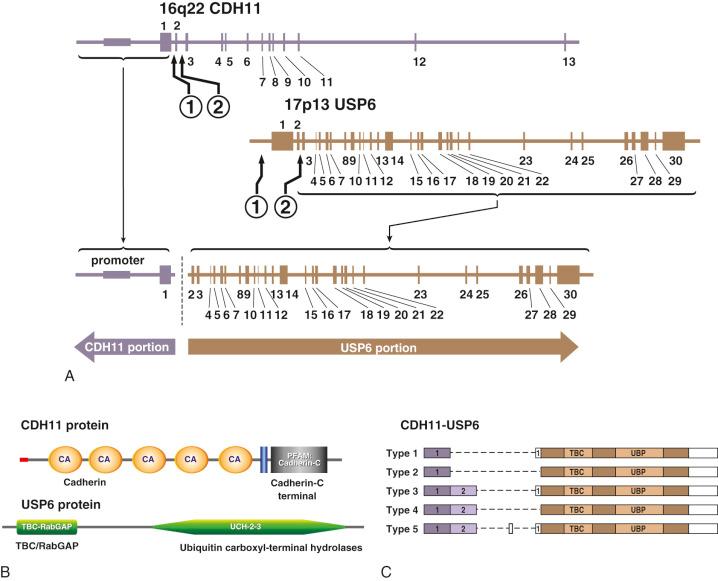
This term is used to describe a peculiar lesion of bone that is characterized by the presence of spongy or multilocular cystic tissue filled with blood. The process is benign in nature, but it is locally destructive and has a high propensity for recurrence. Microscopically, cystic spaces are bordered by septa composed of a well-vascularized, loose, fibroconnective tissue with prominent giant-cell reaction and focal reactive bone formation. In primary, or de novo, aneurysmal bone cysts, no underlying condition can be identified radiographically or microscopically.
Aneurysmal bone cyst is relatively rare, accounting for approximately 2.5% of all primary bone tumors. The male-to-female sex ratio is approximately 1 : 1. The age distribution is strikingly different from that of giant-cell tumor, and almost 80% of the lesions occur in skeletally immature patients who are younger than age 20 years ( Fig. 15-2 ). The peak incidence of this lesion is during the second decade of life. An aneurysmal bone cyst may affect any bone with similar frequency. Hence, its almost uniform skeletal distribution is a unique feature among bone tumors. Aneurysmal bone cyst has a slight predilection for the craniofacial bones and vertebral column, which are involved in 18% and 24% of cases, respectively. The major long tubular bones of the upper and lower extremities account for 20% of the cases. Approximately 12% of cases are located in the small bones of the hands and feet. Tarsal bones are more frequently involved than carpal bones. The flat bones (the pelvis and scapula) are also well-known locations for aneurysmal bone cyst. In the long tubular bones, the metaphyseal areas are preferentially involved. Lesions that involve the ends and midshaft areas of long bones occur less frequently. The typical sites of skeletal involvement are presented in Figure 15-3 .
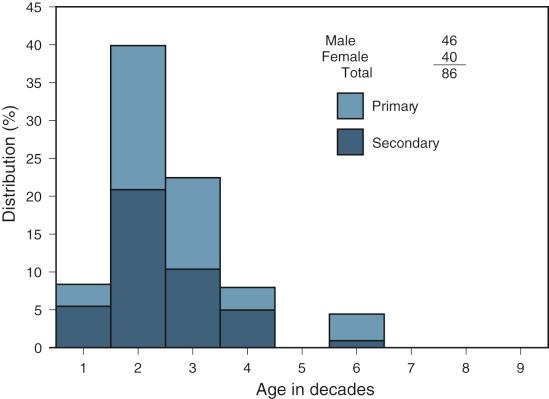
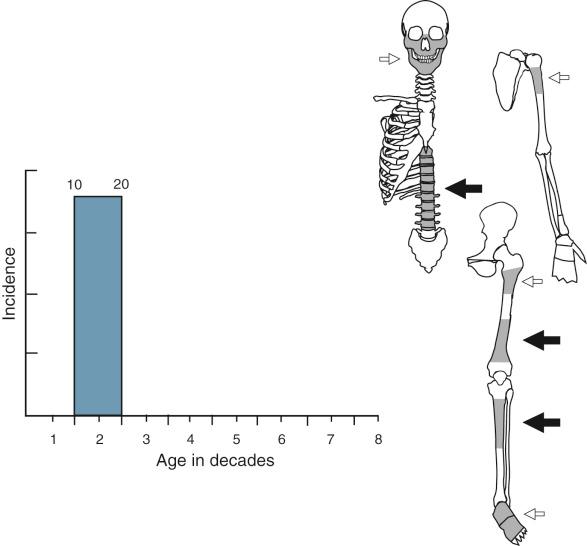
Rare examples of multiple metachronous aneurysmal bone cysts in as many as five different skeletal sites have been reported. Recent observation of a familial incidence of aneurysmal bone cysts have suggested a hereditary factor in the pathogenesis of primary aneurysmal bone cyst.
Pain and swelling (occasionally very pronounced) are the typical symptoms, which may vary in duration from weeks to several years. Occasionally the patient has a relatively short history of pain and swelling that progressively developed over a few weeks. The vertebral lesions typically present with a full gamut of signs and symptoms related to compression of the spinal cord and nerves.
The radiographic presentation is very distinctive, and in most cases the diagnosis of aneurysmal bone cyst is suggested on the basis of x-ray features. The most characteristic feature is a blowout or ballooned distention of the periosteum outlined by a paper-thin shell of subperiosteal bone. The blowout or expanded component is found overlying an area of cortical disruption. The lesion is lytic and may have a “soap-bubble,” multiloculated pattern ( Figs. 15-4 and 15-5 ). The radiographic features are best understood if the lesion is envisioned as an expansile, multilocular balloon disrupting the adjacent bone and elevating the periosteum. The blowout character of the lesion is usually most strikingly demonstrated in the long bones, but it is also evident in other locations ( Figs. 15-6 to 15-8 ). Although rare, reactive bone in the lesion can be documented radiographically as lesional calcifications. The lesion is typically eccentric and involves the metaphysis ( Figs. 15-7 and 15-8 ). Involvement of the end of a bone and midshaft location is less frequent ( Figs. 15-8 to 15-10 ). Aneurysmal bone cysts can cross joints and involve several adjacent bones. This typically occurs in spinal lesions, where several adjacent vertebrae and ribs can be affected. Aneurysmal bone cyst of the vertebral column typically originates in the posterior neural arch and expands unilaterally to produce an eccentric paravertebral blowout lesion. In some cases, destruction of vertebral bodies with partial or complete collapse occurs ( Fig. 15-8, A ).
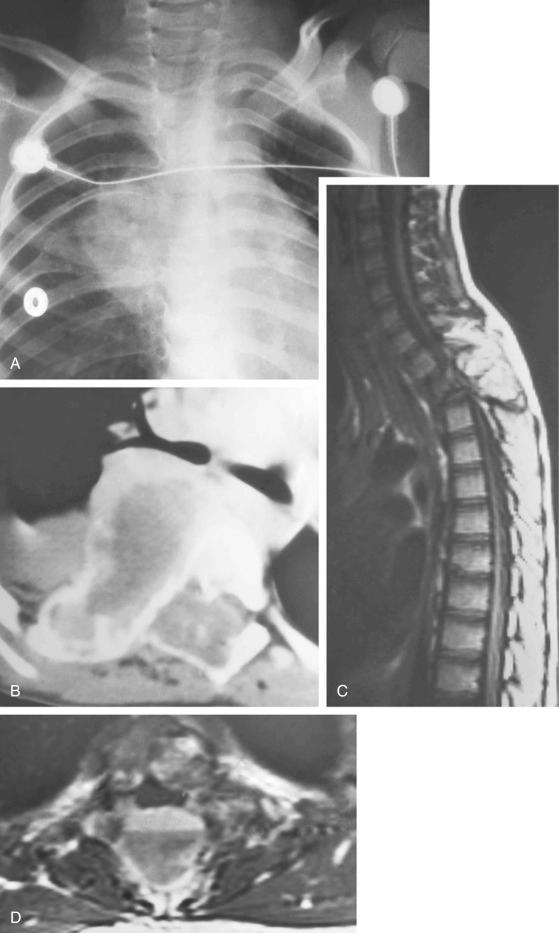
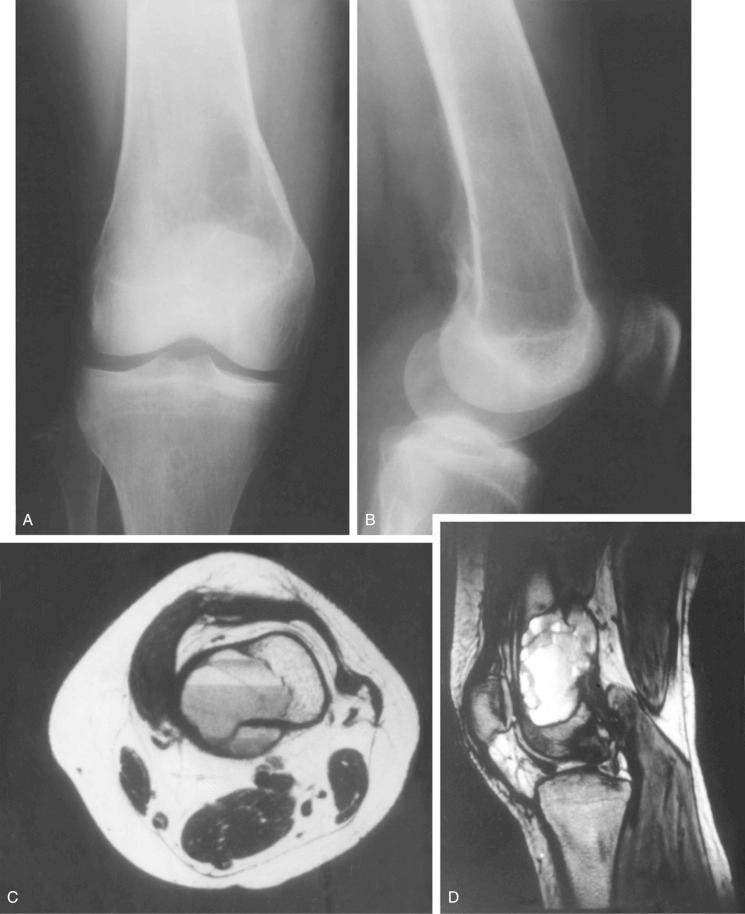
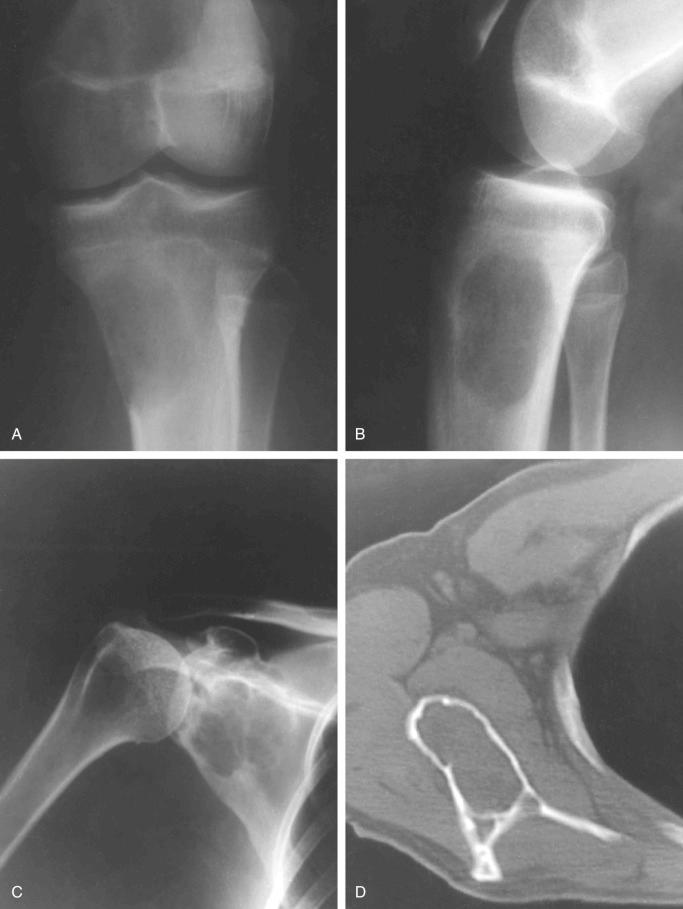
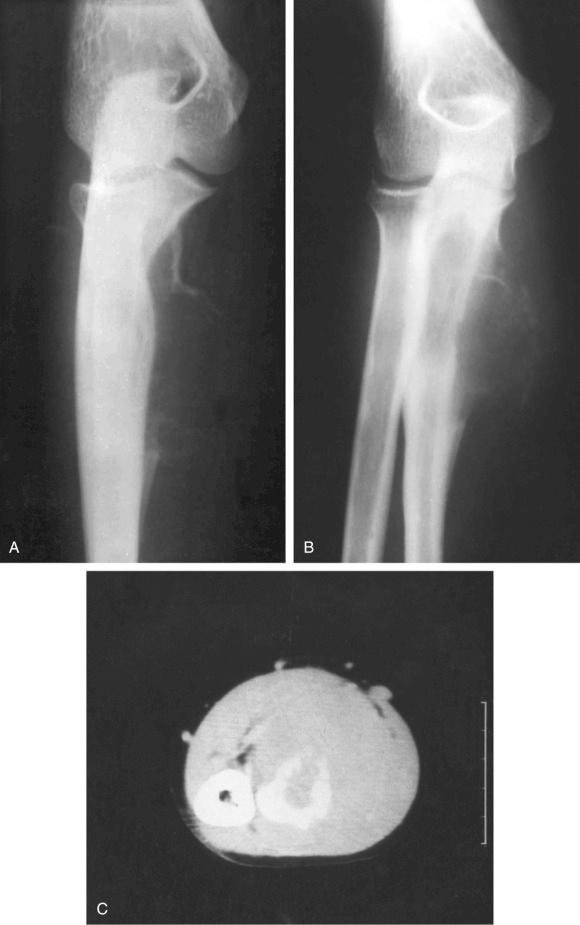
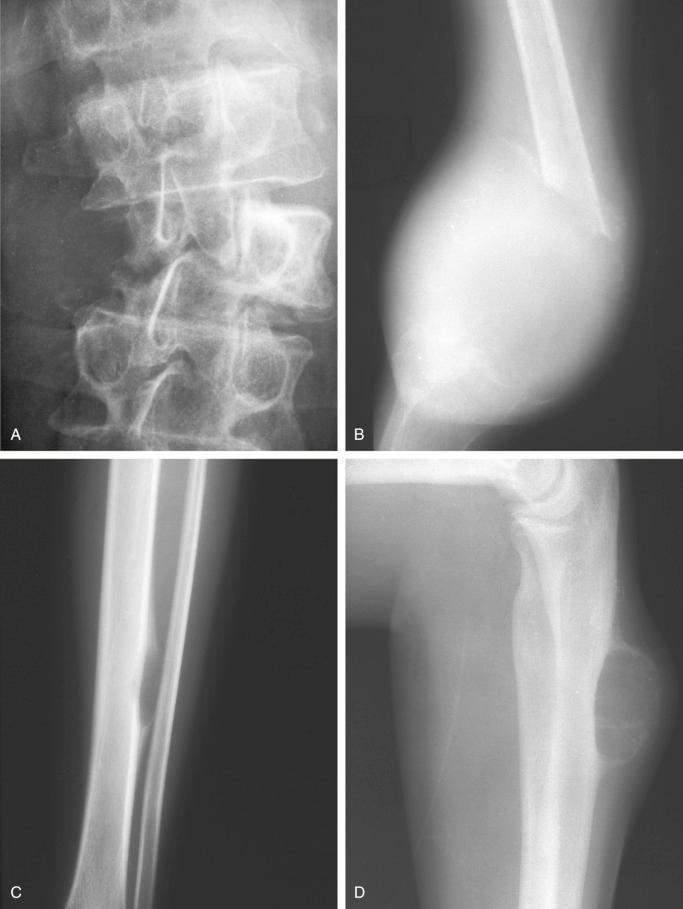
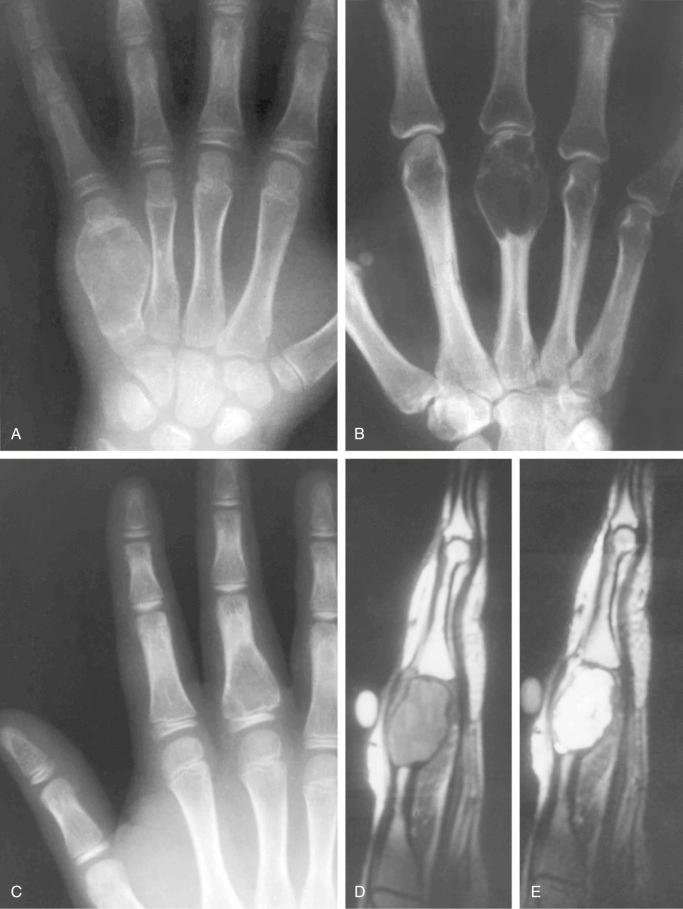
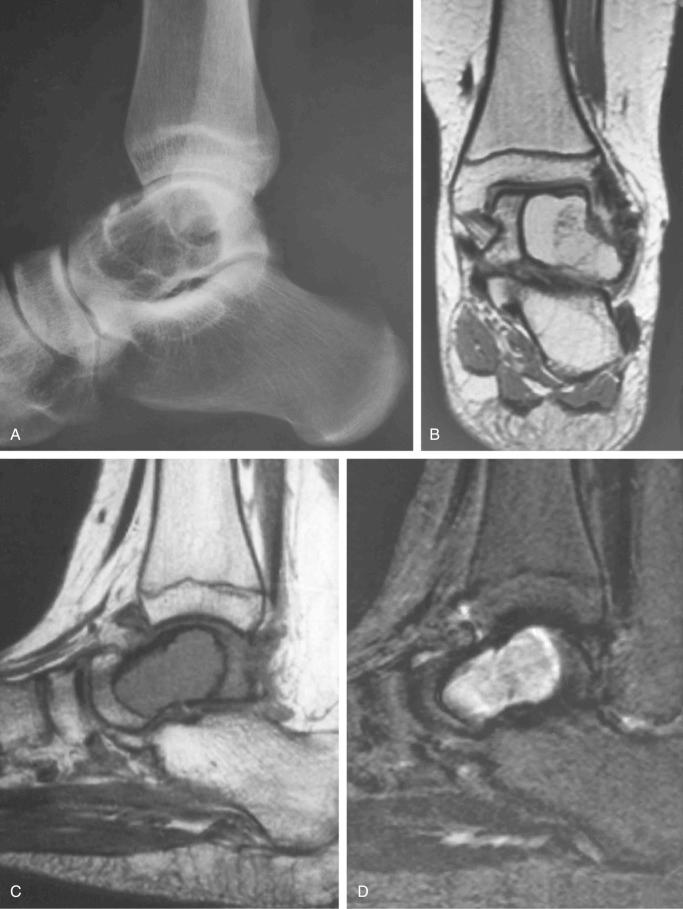
Computed tomography and magnetic resonance imaging are extremely valuable tools in the preoperative evaluation of the lesion because they document the multilocular cystic nature of the lesion and the fluid-fluid levels ( Figs. 15-4 and 15-5 ). Magnetic resonance imaging demonstrates the expansile nature of the lesion, which is encircled by a thin rim of periosteal bone of low signal intensity.
Aneurysmal bone cyst examined in situ appears as a spongy or multilocular cystic lesion filled with blood ( Figs. 15-11 to 15-13 ). The size of the cystic spaces ranges from less than 1 mm (spongy areas) to large cavities that measure several centimeters. The lesion contains only a small amount of spongy, red-brown soft tissue or thin membranous septa. The operating surgeon frequently encounters what appears to be a hole containing blood. The lesion has irregular, lobulated, but sharply demarcated borders. The more solid or spongy tissue is usually found peripherally within the intramedullary component. The central portion and especially the blowout extramedullary component are typically composed of large cystic spaces and blood. The extramedullary component is sharply delineated from the surrounding soft tissue by an elevated and expanded periosteum that has a thin shell of reactive bone.
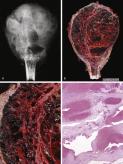
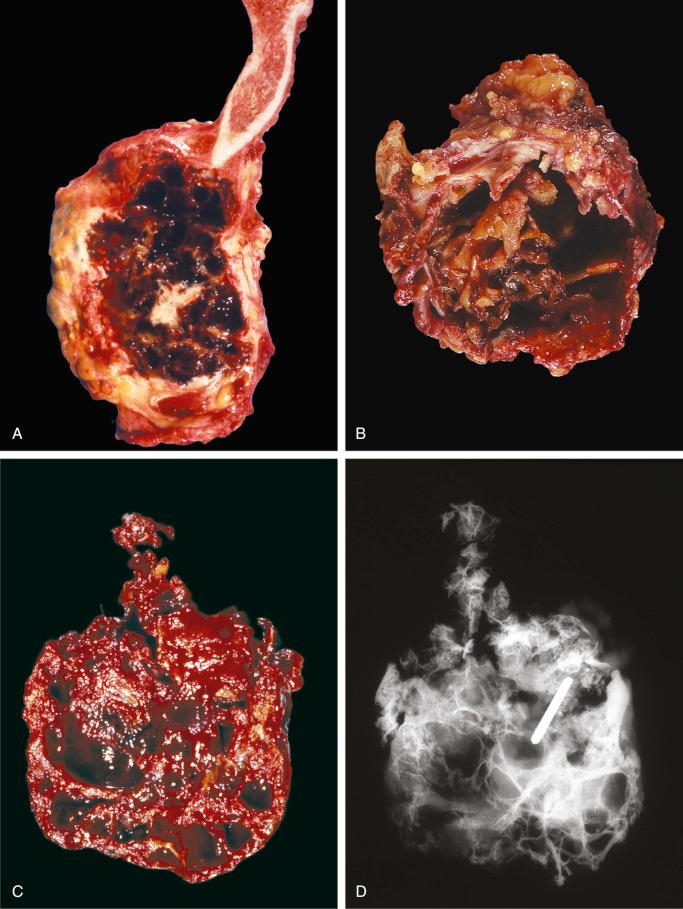
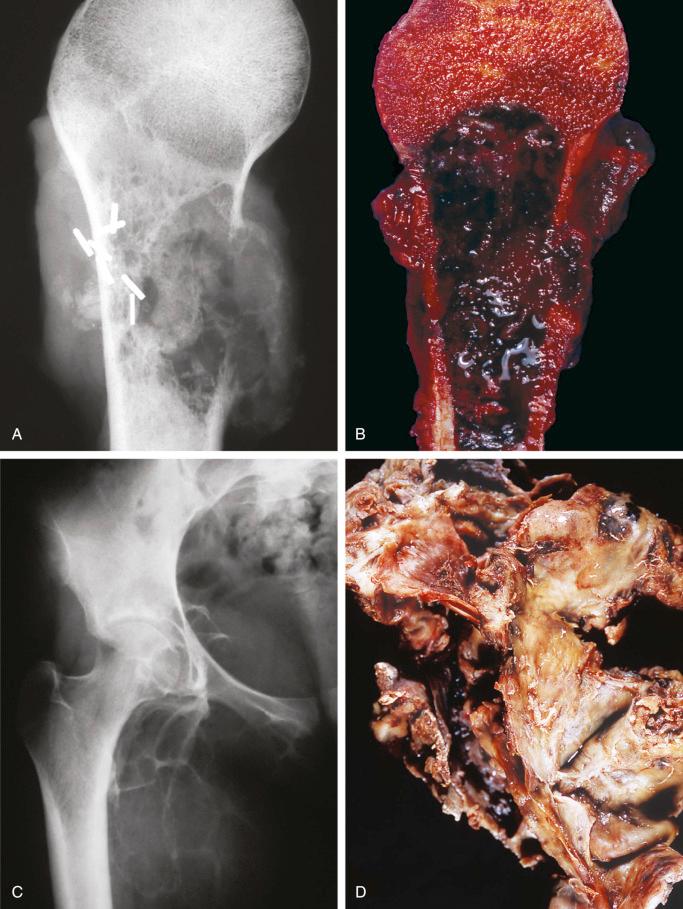
The microscopic features of aneurysmal bone cyst closely parallel the gross findings. The multilocular cystic architecture of the lesion is evident under low-power examination ( Figs. 15-14 to 15-16 ). When curetted material is examined, the collapsed membranous septa of distended cystic spaces and irregular spongy fragments of tissue are present in a background of hemorrhagic material. The septa and more solid areas are composed of loose, fibrous tissue that has numerous capillary channels, multinucleated giant cells, inflammatory cells, and extravasated red blood cells. In general, it mimics young granulation tissue. Occasionally, larger, better formed vascular channels (feeding vessels) that run parallel to the long axis of the septum can be identified. The cystic spaces typically do not have any clearly recognizable lining, but flattened endothelial-like cells can be present focally. Focal presence of endothelial cells can be documented immunohistochemically. However, ultrastructural studies do not confirm the presence of an endothelial lining in the cystic spaces. Giant osteoclast-like cells can dominate the picture and form irregular clusters that are usually located in the area of extravasated red blood cells. Reactive bone formation is almost always present focally and occasionally can be very prominent. Areas of immature reactive osteoid with prominent plump osteoblasts often raise the suspicion of a malignant, bone-forming tumor. Osteoid is frequently deposited in the form of long strands that may be partly mineralized; these strands are oriented parallel to the long axis of the septum. At the periphery, especially within the medullary canal, solid areas of tissue with a prominent vasculature can be present. The surrounding cancellous or cortical bone shows features of resorption with prominent osteoclastic activity. The blowout soft tissue component is delineated by a rim of fibrous tissue representing elevated periosteum. On its inner surface, a shell of reactive bone with prominent osteoblastic activity is typically present.
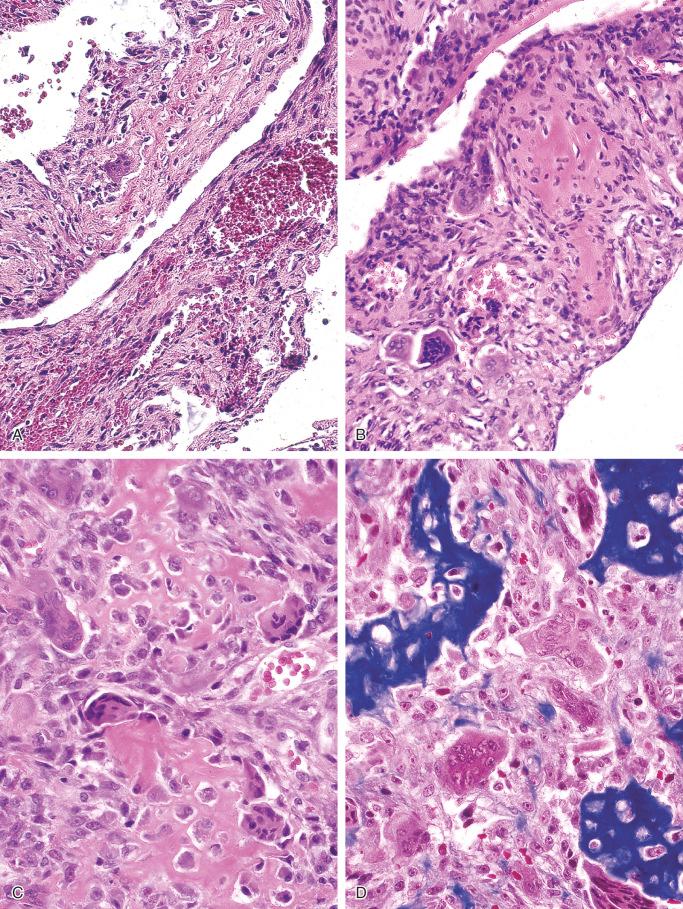
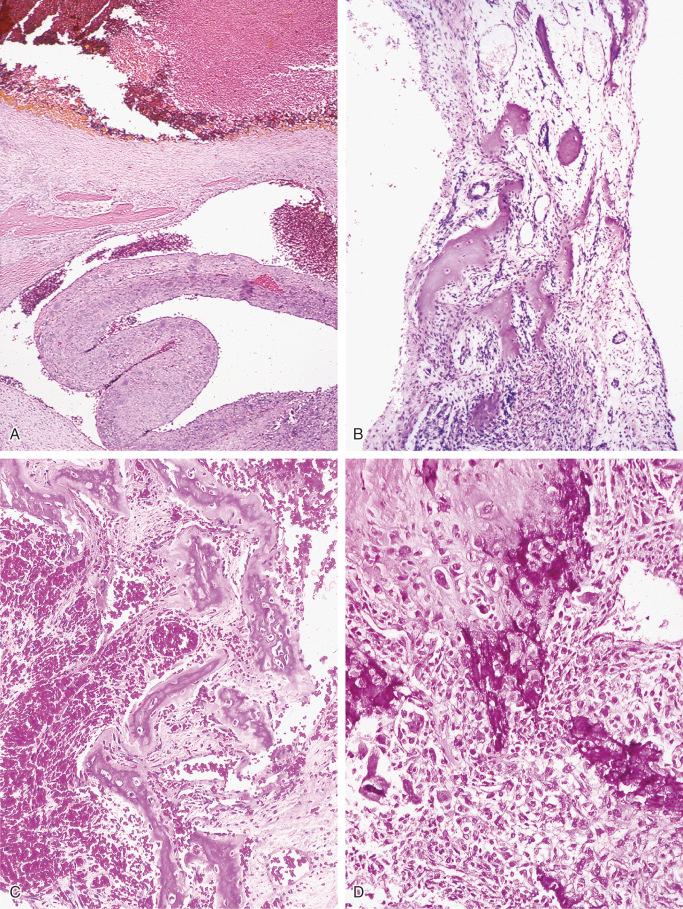
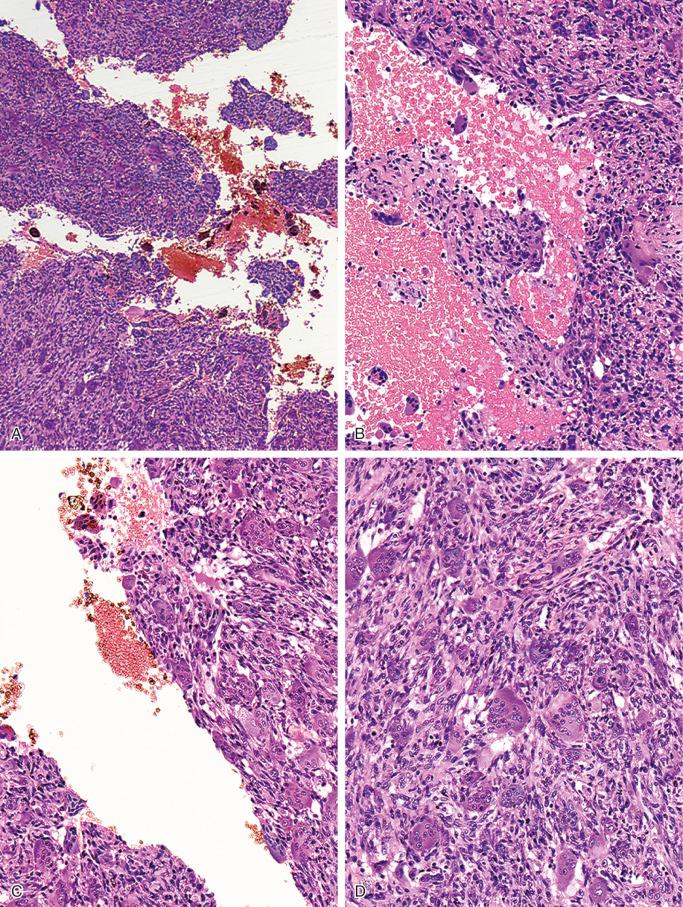
The overall diagnostic approach should be to rule out an underlying condition (i.e., secondary aneurysmal bone cyst). The lesion must be sampled extensively. Any solid areas should be submitted completely for microscopic examination because they are likely to contain elements of a precursor condition.
Distinction from telangiectatic osteosarcoma is the most important diagnostic problem and may be difficult because these two conditions have overlapping clinical and radiographic features. The problem is further amplified by the fact that an aggressive appearance on radiographs may suggest the incorrect diagnosis of malignancy. The distinction between aneurysmal bone cyst and telangiectatic osteosarcoma is ultimately based on microscopic features. The presence of highly anaplastic sarcomatous cells with atypical mitoses producing tumor osteoid is highly diagnostic of osteosarcoma. Some clinicoradiographic clues that are helpful in distinguishing these two conditions are as follows:
Telangiectatic osteosarcoma is uncommon and very rarely involves the vertebral column, small bones of the hands or feet, or craniofacial bones, where aneurysmal bone cyst is common.
Aneurysmal bone cyst typically has a blowout appearance on radiographs. Even expansile, highly destructive lesions usually show an eggshell-like rim of reactive periosteum.
Conventional osteosarcoma rarely exhibits focal features of telangiectatic osteosarcoma. Moreover, a secondary aneurysmal bone cyst may be superimposed on a conventional osteosarcoma. In such instances, pathologic-radiologic correlation is extremely helpful to avoid a misdiagnosis. In the majority of cases, radiographs show a bone-forming, radiodense lesion in addition to a lytic or blowout component. The radiographs may also disclose a discrepancy between the radiographic presentation of the lesion and its microscopic appearance. In such instances, another biopsy can be performed to sample a portion of the tumor that shows the worrisome radiographic features.
The more solid areas of an aneurysmal bone cyst, because they contain numerous multinucleated giant cells, may be confused with a giant cell tumor . An aneurysmal bone cyst can also be engrafted on a preexisting giant-cell tumor. Giant cell tumors may also cause an aneurysmal bone cyst to develop as a secondary phenomenon. Distinction between a giant cell tumor with a secondary aneurysmal bone cyst and a primary aneurysmal bone cyst on the basis of microscopic features alone can be difficult. In such instances, involvement of the end of the long bone, especially in the knee area of a skeletally mature patient, suggests giant cell tumor. Epiphyseal involvement by a similar lesion in a skeletally immature patient suggests a chondroblastoma with a secondary aneurysmal bone cyst superimposed.
Giant cell reparative granuloma is considered by some authors as a common precursor lesion of aneurysmal bone cyst that is synonymous with its solid variant. Giant cell reparative granuloma is predominantly solid and frequently contains microscopic foci of cystic change that are consistent with those seen in an aneurysmal bone cyst; however, the features of an expansile blowout lesion are not seen on radiographs. The identification of USP6 gene rearrangement in giant cell reparative granulomas of the appendicular skeleton, especially those involving the bones of hands or the feet, further confirms the relationship between these two entities. However, the pathogenesis of giant cell reparative granulomas appears to be heterogeneous; those affecting the craniofacial bones are distinct from those in the appendicular skeleton and typically do not carry the USP6 gene rearrangement. More complex description of the molecular background of giant cell reparative granulomas is provided in Chapter 10 . In general, the identification of the clonal USP6 gene rearrangement in aneurysmal bone cyst, giant cell reparative granulomas, and myositis ossificans provides important clues to the pathogenesis of these conditions and may be useful in their differential diagnosis.
A solitary bone cyst may occasionally be confused with an aneurysmal bone cyst in biopsy material. Foci of hemorrhage associated with a pathologic fracture of a solitary cyst may contain multinucleated giant cells and reactive bone, which can closely simulate aneurysmal bone cyst. In such instances, a review of radiographs is extremely helpful. In addition, the mentioned giant cell–containing areas are typically focal, and the remaining material shows the bland-looking fibrous membrane of a solitary bone cyst.
Aneurysmal bone cysts are locally destructive lesions that may produce severe deformity and functional impairment. Lesions located in the vertebral column or in the craniofacial bones can compress vital structures and cause serious disability or death, which is unusual. The overall prognosis is good; approximately 90% of patients have satisfactory long-term treatment results. The kinetics of the lesion can vary from case to case. Some lesions do not increase in size and may develop radiographic features of intralesional sclerosis. Most lesions, however, increase in size and eventually require surgical intervention, other therapeutic measures, or a combination of treatments to stabilize the process and to prevent further damage.
The most effective treatment is complete surgical excision of the lesion, but in many instances such an approach may produce a major functional impairment. Therefore most lesions are treated by curettage and bone grafting. Unfortunately, this type of treatment is associated with a high recurrence rate that ranges from 20% to 70% in different series. Recurrence typically occurs within 6 months after treatment and almost never occurs after 2 years. Cryotherapy has reduced the rate of recurrence to 8% in one report. In some instances, in situ transcatheter embolization can be performed. However, the clinical value of such treatment has not been established in larger series. Percutaneous injection of calcitonin, methylprednisolone, and sclerosing agents such as Ethibloc have been reported to be effective in inducing shrinkage and healing. Adjuvant radiation therapy is reserved for treatment of lesions that cannot be completely excised because of their location and to prevent damage to functionally important structures, such as the spinal cord. Rare cases of high-grade sarcoma (osteosarcoma and malignant fibrous histiocytoma) developing at the site of a previously treated aneurysmal bone cyst have been described. Most of these patients received radiation therapy. Examples of spontaneous malignant transformation without previous radiation therapy also have been described.
The term secondary aneurysmal bone cyst is applied to aneurysmal bone cysts that are superimposed on a preexisting condition. The prognosis and behavior of these lesions are generally determined by the biologic potential of the underlying condition.
More than 50% of all aneurysmal bone cysts are superimposed on a recognizable precursor condition. The age-related distribution patterns of primary and secondary aneurysmal bone cysts are similar and show a single peak during the second decade of life ( Fig. 15-2 ). Both variants of aneurysmal bone cyst are rare in patients older than age 30 years. This indicates that young individuals, especially those who are skeletally immature, are more likely to develop this process, either as a primary or secondary phenomenon, compared with older individuals. In contrast to primary aneurysmal bone cyst, secondary aneurysmal bone cyst is more frequently found in weight-bearing bones. On the other hand, there is no difference in predilection of primary versus secondary aneurysmal bone cyst in non–weight-bearing sites.
The radiographic appearance of secondary aneurysmal bone cyst reflects the superimposition of a blowout lesion on the radiographic features of the preexisting condition ( Figs. 15-17 and 15-18 ). Quite frequently, the underlying condition can be identified only microscopically. Because of the anatomic location, involvement of specific areas of bone, the age of the patient, and other factors, certain preexisting conditions can be anticipated. In the long tubular bones, involvement of the ends of bone in skeletally immature patients and blowout lesions of tarsal bones suggest that chondroblastoma could be the predisposing condition. Chondroblastoma is almost invariably a source of a blowout lesion that develops in the calcaneus. It also should be suspected in the differential diagnosis of blowout lesions of the acetabulum. In skeletally mature patients, giant cell tumor is the frequent underlying condition of the blowout lesion in the end of long bones, especially if it involves the knee area. Giant cell reparative granuloma is a frequent predisposing condition for the development of secondary aneurysmal bone cyst in the small bones of the hands and feet and in the mandible. Fibrous dysplasia should be considered in reference to lesions located in the shafts of long bones of the extremities, in the ribs, and in the craniofacial region. In the metaphyseal parts of the long tubular bones, especially in a lower extremity, lesions such as nonossifying fibroma and, less frequently, chondromyxoid fibroma should be considered. The most frequent underlying condition for secondary aneurysmal bone cyst of the vertebral column is osteoblastoma. Osteoblastoma should also be anticipated in sites such as the mandible and the maxilla. An expansile, fluid-filled lesion of the sacrum typically represents an aneurysmal bone cyst superimposed on a giant cell tumor. The most frequent underlying conditions for secondary aneurysmal bone cyst are listed in Table 15-1 . It must be remembered that aneurysmal bone cyst is rarely superimposed on primary or metastatic malignant tumors. All bone lesions containing components with rich vasculature may occasionally develop aneurysmal bone cysts as secondary phenomena. Therefore it can be seen even in such conditions as vascular cartilaginous hamartoma.
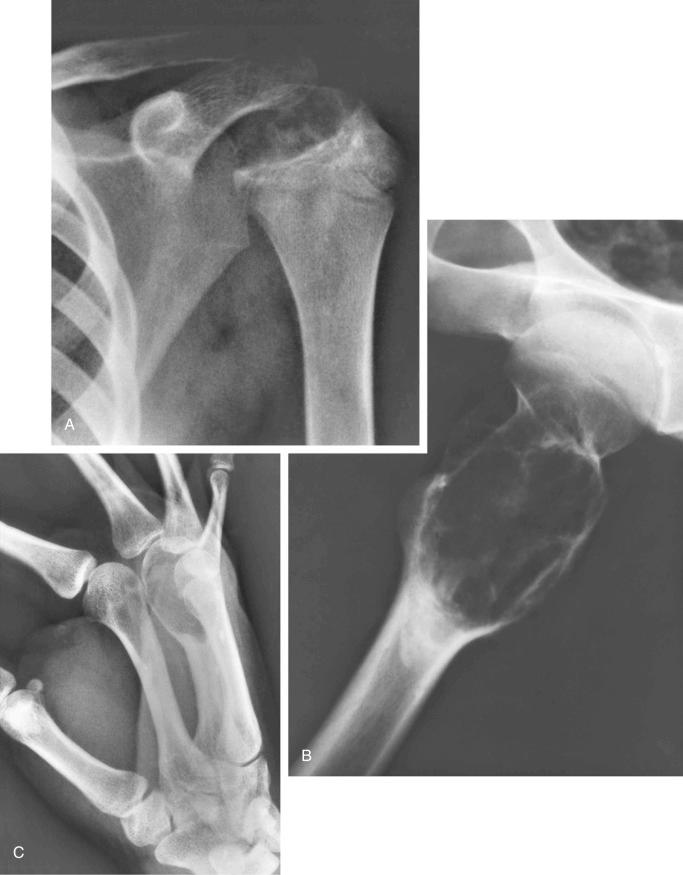
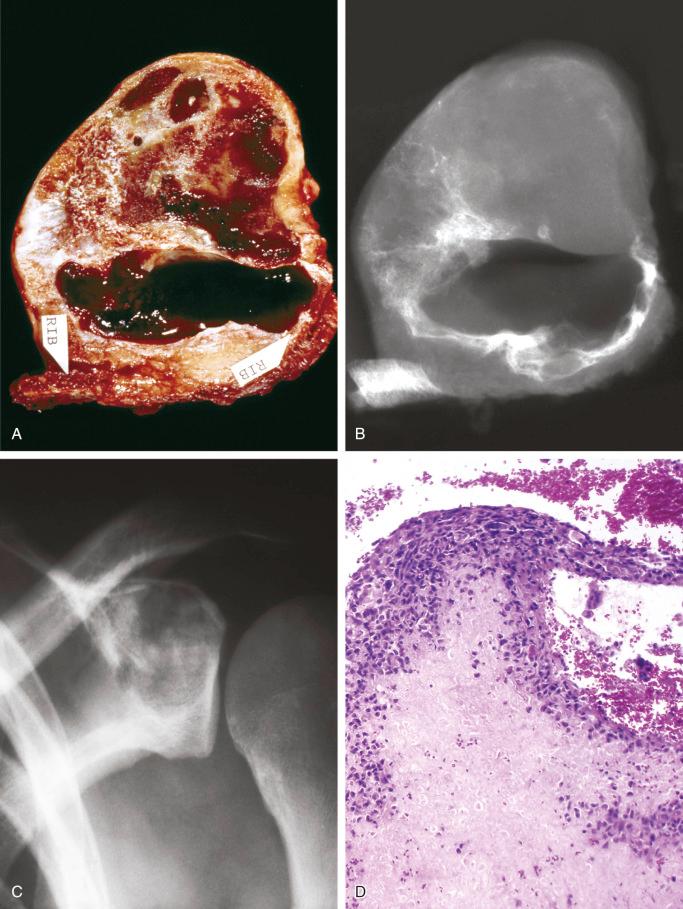
| Giant cell tumor | Eosinophilic granuloma |
| Chondroblastoma | Hemangioma |
| Osteoblastoma | Myositis ossificans |
| Nonossifying fibroma | Osteosarcoma |
| Fibrous dysplasia | Malignant fibrous histiocytoma |
| Giant cell reparative granuloma | Metastatic carcinoma |
| Chondromyxoid fibroma | Miscellaneous lesions containing rich vascular network (hamartoma) |
| Fibrous histiocytoma | |
| Solitary bone cyst |
Become a Clinical Tree membership for Full access and enjoy Unlimited articles
If you are a member. Log in here